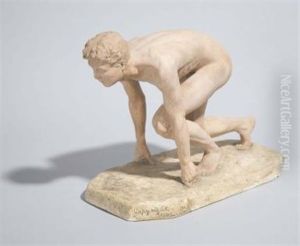Robert Tait Mckenzie Paintings
Robert Tait McKenzie, born on May 26, 1867, in Ramsay Township, Ontario, Canada, was a multifaceted individual known for his contributions as a sculptor, physician, athlete, and educator. McKenzie attended McGill University in Montreal, where he excelled in athletics and developed a keen interest in human anatomy and the physical form, which would later significantly influence his artistic work.
After graduating with a medical degree in 1892, he became a physical education instructor at McGill and a physician, specializing in sports medicine. His medical career was distinguished, and he served as a surgeon during World War I, which further deepened his understanding of the human body in motion and at rest.
McKenzie's artistic career began to flourish in the late 19th and early 20th centuries. His sculptures primarily focused on athletes and the athletic form, capturing the beauty and dynamic movement of the human body. He became known for his 'athletic ideal,' which emphasized a balance between physical activity, moral character, and intellectual development. His most famous work, 'The Joy of Effort,' showcases this ideal and can be found at the International Olympic Committee headquarters in Switzerland.
In addition to his sculptures, McKenzie was also an educator and author, publishing books on physical training and the importance of physical education. He served as the director of the Department of Physical Training at the University of Pennsylvania from 1904 to 1929, where he influenced the field of physical education and the study of anatomy as it related to exercise and sports performance.
McKenzie's legacy as an artist and educator lives on in his sculptures, which can be found in various institutions and public spaces, and in his contributions to the fields of physical education and sports medicine. He passed away on April 28, 1938, in Philadelphia, Pennsylvania, leaving behind a rich body of work that continues to inspire and educate.

